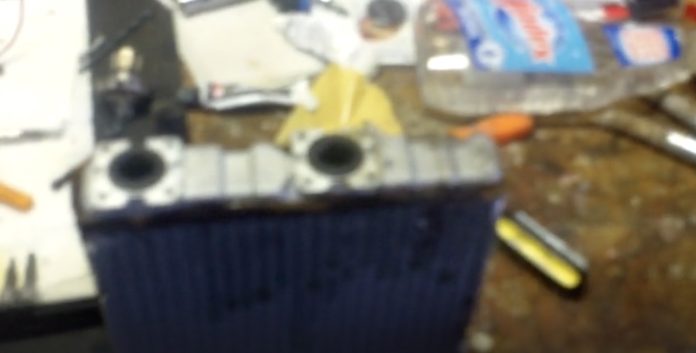I finally got the leaking heater core out of my old Nissan Frontier (’02 model year, so now 23 years old) and found a couple of interesting things that you may find interesting – especially if you happen to own an older truck. Or an older car or crossover/SUV, for that matter.
The first thing is that my old core was clogged – as well as leaking. Once I got it out and on my workbench, I was able to see inside. The internals were gunked up with something and that almost certainly accounted for what I always thought was the mediocre heating of my truck’s passenger cabin, which I attributed to “just the way it is.” Some vehicles have better heat than others. But I no longer think it was that. I think the previous owner either used Stop Leak in the cooling system – which stops radiator leaks by plugging small holes, so as to mask but not really fix the problem while also filling the system with funk that plugs up the system. Or he used contaminated (tap) water radiator in the system, which can lead to calcification build-up.
I think so because I remembered the truck’s engine ran hot when I bought it about 15 years ago. I had to replace the radiator – which cured that problem. But it did not fix the heater core, which remained a latent (just not yet leaking) problem for the next 15 years. Stop Leak is n expedient. It isn’t a repair. It is often used by people selling a vehicle with a leaky radiator that don’t want to pay to replace the radiator before they sell (or trade) the vehicle in. Using tap water is another expedient in that it’s easier than going to the parts store for a jug of coolant. But you ought to – if you want to avoid down-the-road (and possibly expensive) problems with your vehicle’s cooling system. It is also important to be sure you use the correct, factory-specified coolant that is compatible with your particular make/model’s cooling system. This information will be in your owner’s manual and also sometimes on the radiator fill cap.
The other thing I found out is something you may already know about. It is that critical parts for older vehicles may no longer be available – from the manufacturer
In my case, the critical parts are a pair of transfer tubes that convey the warm engine coolant from under the hood to the heater core under the dash and then back to the engine, to be warmed up some more. These two tubes bolt to mounting bosses on the core and so you absolutely have to have them for the system to connect. You’d think just having outlet nibs on the core that generic hoses could be fitted onto and tightened up would be smarter but it actually isn’t because those hoses are made of rubber and they will eventually deteriorate and leak.
Then again, so will plastic – which is what these tubes are made of. As I mentioned in my earlier report about this project, I decided it would be smart to replace those 23-year-old plastic tubes with brand-new ones that would last another 23 years. Also, they’d come with new o-rings to replace the 23-year-old crushed and tired o-rings that were attached to the old core.
So I went to the Nissan store. And it was there that I learned these parts had been discontinued. This surprised me, a little. In part because even though my ’02 Nissan is almost old enough to qualify for Antique Vehicle plates, I do not look upon it as old. Also, Nissan made so many of these trucks. I see doppelgangers of my truck every time I go for a drive. You’d think (well, I’d think) Nissan would continue to stock parts for popular models, even if they’re no longer making that model.
That used to be the case – and still is, in some cases. I have a nearly 50-year-old Pontiac and I have never had any trouble finding service parts for it. Part of the reason being that it is a popular model, of course. But there is another reason. When it was made – back in late 1975 – American cars generally shared many parts and these interchanged between makes and models. For example, my Pontiac’s suspension parts are in many cases the same as the past used not just in other Pontiac models of the period but also Chevys and Buicks, too. Plus, models used to stay mostly the same for longer.
So parts were around for longer.
Today, cars have a much shorter shelf life. A new model generally gets “updated” after four years and totally revamped not long thereafter. After which, the older design is shortly no longer supported – very much like an aging-out smartphone. And because critical parts – especially electronic parts – are very specific not just to that make/model but also to that particular year/vehicle – it can mean you can’t fix whatever it is that’s not working. Not unless you can find a used part that’s still working. There are fewer and fewer of them as the years pass.
On the upside, it is also true that replacement parts for discontinued parts are available from aftermarket suppliers, as on eBay. That’s where I found a set of new tubes for my truck and I’m waiting for them to arrive so I can put everything back together and have heat – hot, this time – again!
. . .
If you like what you’ve found here please consider supporting EPautos.
We depend on you to keep the wheels turning!
Our donate button is here. We also accept crypto (see below).
If you prefer not to use PayPal, our mailing address is:
EPautos
721 Hummingbird Lane SE
Copper Hill, VA 24079
PS: Get an EPautos magnet or sticker or coaster in return for a $20 or more one-time donation or a $10 or more monthly recurring donation. (Please be sure to tell us you want a magnet or sticker or coaster – and also, provide an address, so we know where to mail the thing!)
If you like items like the Baaaaaa! baseball cap pictured below, you can find that and more at the EPautos store!

The bitcoin code is: 3GAfymoqSUbaFvY8ztpSoDKJWCPLrkzAmi if you’re unable to scan the QR code above!











My stable of cars and trucks hail from model years 1973, 2001, 2002, 2004 and 2010.
They’ve been astonishingly reliable.
My worry, though, has increased as the years progress.
Something will eventually break or wear out that can’t be replaced.
Then what?
YOU NEED A PERMIT NOW TO CHANGE CAR OIL AT HOME IN THIS AUSTRALIAN CITY
Another way to stop slave mobility…..you can’t work on your own car….
https://www.youtube.com/watch?v=WFrcg9JTfk8
My friend has a ’99 Ford Explorer that he has me do minor work on like fluid exchanges and tuneups. A few years ago, during the height of Wuhan China virus craziness, he had me flush the cooling system and he insisted we add a liquid stop leak (Bar’s) because he believed he had a head gasket leak. I questioned that because his engine was running pretty well and there was no oil contamination. Also he had just had a new radiator installed. It went in anyway.
Long story short, last year he started having excessive coolant level dropping and lost heat in his truck. Annoyed, he brought it in to an independent mechanic who found his radiator was shot and leaking everywhere. The diagnosis? The stop leak ruined his new radiator. Over $300 to replace it and all the contaminated coolant. And he was warned not to put anything in the cooling system again.
So what did he recently do? Taking the suggestion of a automotive radio show host by the name of Ron Ananian (The Car Doctor?), he dumped something else in there and now the coolant is colored blue! I’m waiting for the radiator to fail again.
The “remedy”, if you’re fortunate enough to buy your ride new or nearly-new, is to run the HEAT at least once a month from about 01 April to 31 Oct, and in contrast, run the A/C at least once monthly, from about 01 Oct to 30 April, each year. This practice prevents both water stagnation in the heater core, and where a rotary seal is used (on some compressors), keeping pressure against one particular part too long.
And yes, use only distilled water in your car’s cooling system, and, if needed, to top off the battery. Even batteries w/o caps that are easily pried off need water, or at least, to be checked! The better practice WRT a cooling system is to keep a jug of “pre-mix” of the proper coolant handy and top off with THAT. If you have to top off frequently, then either there’s a leak somewhere that you’ll have to track down, or you have a weak radiator cap.
The OEMs manufacture a stop leak product that won’t clog. The Delco stuff is made of ginger pellets. I believe GM used to drop them right into the radiators on the assembly line.
I think Motorcraft has a similar product.
If such a product is used at the factory, then I’d guess they’d tested the procedure over time to make sure it didn’t cause more problems that it’d solve. A matter of, they want to pay for FEWER warranty claims.
Hi Eric,
You may want to leave the bypass loop in place and have the coolant flushed and then replace the thermostat and hoses and clamps, then use fresh antifreeze at an 80% / 20% distilled or R/O water mix, or the long life antifreeze. I know and understand mission creep. I own 2 cars that are over 30 years old, one with a V12 so I feel your pain. I have been buying parts such as ignition switches, gaskets, etc. as so much is going NLA. Dorman makes good stuff.
Indeed, Peter!
I’ll be draining/flushing the system before reconnecting the new heater core. It’s also a fine time to change the hoses to the core as well as any related thing that needs attention. Hopefully I’ll have it all back together by the weekened!
Gates brand ONLY. Costs a bit more. Worth EVERY penny.
One of the reasons I like and drive really old stuff is that most of the parts not available can be made. Cars and trucks from the 50s and older can usually be kept going with a few machine tools and a welder. Curved glass is a big problem unless you’re into really common and popular stuff like 55-57 Chevys. Flat glass can be cut. Not being a purist allows me to do seriously good upgrades like suspension swaps, giving modern brakes, wheels, tires, and handling to resto rods and mods.
It is amazing how a couple heater tube stubs can spell the end of an otherwise perfectly good vehicle. Many owners would have just junked your Nissan.
Happy New Year!
Not being able to see exactly what you’re working with my question is, is it possible to use NPT hardware and lines to replace the original? I’ve found that it can really be handy and inexpensive as an alternative to NLA factory plumbing. A friend had a Fiat 131 and he got such a rig and bypassed the dash control for heat by using a simply plumbing valve.
Hi Mark,
I found (and ordered) the replacement tubes on eBay. The will bolt properly to the bosses on the core – and they come with new o rings, which will replace the crushed ones that are there now! Should have it all back together by the weekend, assuming the parts get here before then!
Please tell me they’re not “Chinesium”!
If you travel out through the Volunteer State, look up “Uncle Tony”, not far from Nashville! Although his YT channel is definitely about cars, more Mopar-oriented, methinks you’d like his politics.
https://www.youtube.com/@UncleTonysGarage
Yup, Doug – the finest parts that Chyna can make!
If I get five years more, I’ll be happy. Hopefully, I’ll be able to swing a newer Tacoma by then…
Sorry to hear about the blockage.
Stop leak is the worst. I’m always amazed by the crap people will willingly put into an engine.
AC refrigerant with “leak stopper” additives are another example.
In either cases the collateral damage almost always outweighs the expedient “fix” of getting the leak stopped.
Note carefully how your premonition to just reuse the two pipes was conciously overridden by your experience and obvious desire to never fight a bloody battle twice.
I had a feeling stop leak was involved in your case. Heater cores w plastic end tanks fail by separation slowly drip by drip and sysyem pressure loss.
Stop leak allows pressures to build to explosion point.
Good work youdidit !
You have aviation potential.